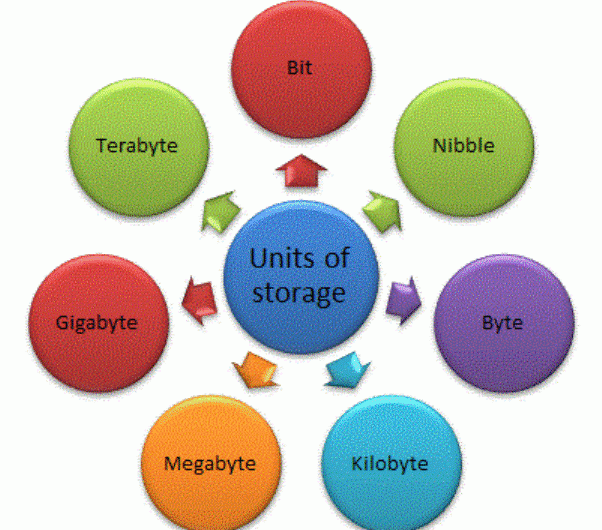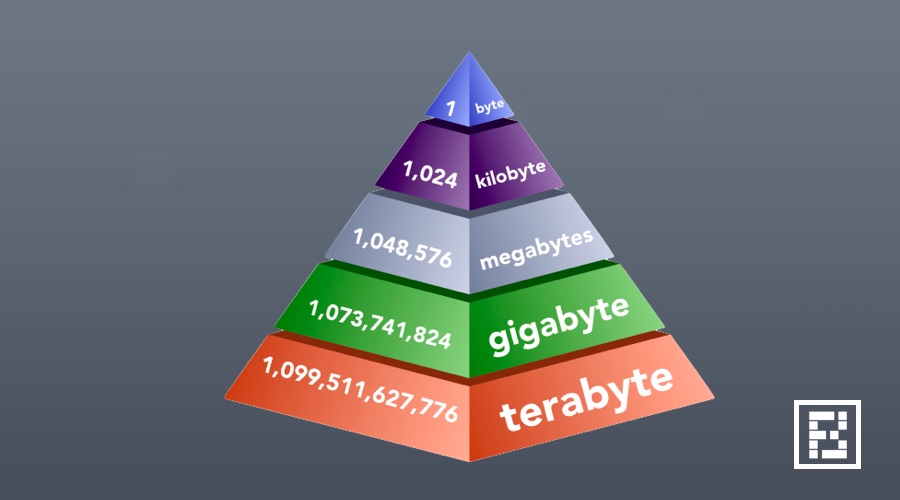Back to: COMPUTER SCIENCE JSS2
Welcome to Class !!
We are eager to have you join us !!
In today’s Computer Science class, We will be discussing the Units of Storage in Computer. We hope you enjoy the class!

Units of Storage in computer
A byte is the most common unit of storage in a computer which is equal to 8 bits. Computer memory is made up of millions of bytes. All data and information fed into a computer, as well as the program that comes preloaded, is stored in the form of bytes.
Each byte resides temporarily on the computer memory and this specific location is called an address.
The size of a computer’s memory differs. The size of a computer’s memory is stated by the manufacturer in terms of bytes.
- 1,024 bytes make a kilobyte (KB)
- 1 megabyte (MB) is equal to 1,024 kilobytes
- 1 gigabyte (GB) is equal to 1,024 megabytes
In order to make calculations and definition of memory size easier, 1.024 bytes are often rounded off to 1000 bytes. Thus, the user will often state that 1 KB is equal to 1000 bytes.
BITS:
Bits comes from the word binary digit. It is the first and smallest unit of memory. A bit makes use of 0 and 1. With bits, data are stored internally as zeros and ones and it is highly machine-dependent.
Group of bits makes up storage units in the computer called character, bytes, or word, which are used as a group. A bit is the basic unit of information in computing and data transmission.
BYTE:
A byte is a character containing 8 bits e.g. 10101111 and it is the smallest group of bits used by a computer. A byte is the basic unit of storage in the computer memory. One byte is one character. A character can be a number, letter, or symbol.
A byte is a unit of digital information in computing and data transmission that most commonly consists of eight bits. The actual standard of eight bits is a convenient power of two (2⁸) i.e. 256 values thus permitting the values 0 to 255 for one byte.
KILOBYTE (KB):
One kilobyte is 1024 bytes. A kilobyte (KB) is a decimal multiple of the unit byte for digital information or computer storage.
The prefix kilo (symbol K) is defined in the International System of Units (SI) as a multiplier of 10³, therefore, 1 kilobyte = 10³ bytes = 1000 bytes.
At the same time, conventionally, this metric prefix is used to designate binary multiplier 2¹⁰ = 1024, so 1 Kilobyte = 210 =1024 bytes.
MEGABYTE (MB):
One megabyte is 1,048,576 bytes. A megabyte (MB) is a decimal multiple of the unit byte for digital information or computer storage.
The prefix mega (symbol M) is defined in the International System of Units (SI) as a multiplier of 10⁶, therefore, 1 megabyte = 10⁶ bytes = 1,000,000 bytes.
At the same time, this metric prefix is used to designate binary multiplier 2²⁰, so 1 MB = 1024 KB.
GIGABYTE:
One gigabyte is 1,073,741,824 bytes. A gigabyte (GB) is a decimal multiple of the unit byte for digital information or computer storage.
The prefix Giga (symbol G) is defined in the International System of Units (SI) as a multiplier of 10⁹, therefore, 1 gigabyte = 10⁹ bytes = 1,000,000,000 bytes.
At the same time, usually, this metric prefix is used to designate binary multiplier 2³⁰, so 1 GB = 1024 MB.

TERABYTE:
One terabyte is 1,099,511,627,776 characters. A terabyte (TB) is a decimal multiple of the unit byte for digital information or computer storage.
The prefix Tera (symbol T) is defined in the International System of Units (SI) as a multiplier of 10¹², therefore, 1 terabyte = 10¹² bytes.
At the same time, this metric prefix is used to designate binary multiplier 2⁴⁰, so 1 TB = 1024 GB.
NIBBLE:
This is a unit of storage that is equivalent to 4 bits i.e. half a byte.
There are sixteen (2⁴=16) possible values of a nibble, therefore it corresponds to a single hexadecimal digit.
WORD:
It is a set of characters with the same relationship which is treated as a whole entity. In computers, characters are organised in units of storage known as either the word or the byte.
A word is a group of 4 consecutive bytes i.e. 16 bits. A word is divided into two – Double word and Quad word. A doubleword is made up of two words which is equal to 4 bytes i.e. 32 bits, while the quadword is made up of 4 words which is equal to 8 bytes i.e. 64 bits.
A computer word is a group of a fixed number of bytes which varies from computer to computer but is fixed for each computer. The length of a computer word is called word length, which is in the range of 1 byte to 64 bytes. It implies the number of its which can be handled like a single operation.
We have come to the end of this class. We do hope you enjoyed the class?
Should you have any further question, feel free to ask in the comment section below and trust us to respond as soon as possible.
We have come to the end of this term. It’s been a remarkable journey and we are glad that you have made it this far. The Journey still continues though, we are moving on to Second Term and hope to see there.
